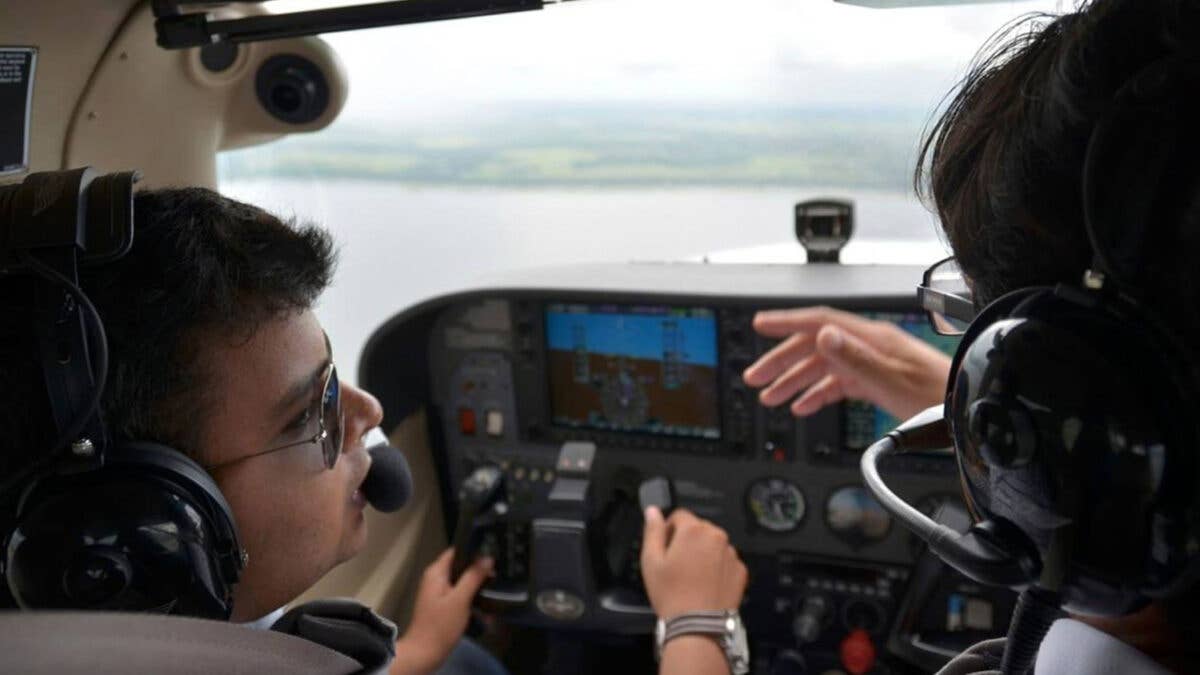The Confidence Factor in Learning to Fly
Here’s a list of red flags that can undermine the learning process and tips for how to course correct.

One reason behind a student pilot’s delay in taking a check ride could be the result of not having confidence. [Courtesy: Wayman Aviation]
Confidence is one of those attributes a pilot must have in just the right amount. Too much makes you the poster child for hazardous attitudes. Too little, and your training can stretch out, despite the urging of your instructor that you're ready for the check ride.
Development of Confidence
The learner's confidence often comes from their trust of the instructor.
Does your instructor inspire confidence? Do they have a vested interest in your training? Do they get excited for you when you reach a milestone like your first solo? Do they come up with creative ways of teaching when you are having difficulty? Or do they become frustrated when you're not getting it and complain that they are "too good" to "still be a CFI?"
While you don't necessarily have to like your instructor, you do need to respect them, and they need to respect you for learning to take place. If respect is not present, the best thing to do is change instructors.
Practice and Drill
"Why are we doing this again?" the learner asked when the CFI asked for a demonstration of ground reference maneuvers.
The answer is because practice and drill increase proficiency, and proficiency results in confidence. A good portion of your flight training will be reviewed to make sure you consistently meet the airman certification standards (ACS).
On the ground drill can mean taking practice knowledge tests—as few as 10 questions at a time —until the material is learned, or going through practice check ride oral exams until the material is understood, not just delivered by rote.
What Hurts Confidence
Confidence is shaken if the learner gets the impression the CFI is making up answers to questions or if the CFI puts the learner into dangerous situations, like flying in a thunderstorm or icing conditions.
Some CFIs make excuses, like the CFI who flew into a closed airport twice (two different airports) with a learner because he didn't check the NOTAMs. I asked the CFI why he didn't check the NOTAMs before the flight and was told "that's the student's job." Riiiiiight. Apparently he hadn't taught his learner how to check NOTAMs because no one taught him.
- READ MORE: When Flight Training Stalls
If a flight is going poorly, the worst thing an instructor can do is tell the learner "just sit back, I'll take us back to the airport." It's much better if the CFI engages the learner, if at all possible. If they don't physically want to fly, have them run the radios, do navigation—all the while asking them to take the controls again.
The exception to this is when the learner does something willfully dangerous, like attempting to buzz something on the ground or not listening to the CFI when they tell the learner to go around. If the CFI has to take the controls to prevent a crash because the learner cannot follow directions, remove them from training.
Disengaged CFI
If the instructor views teaching as a chore, or complains how they want to move on, the learner can start to wonder if they are truly getting an education or simply paying for someone else to pad their logbook. This erodes learner confidence.
I wish I had a dollar for all the times I have heard pilot candidates remark they weren't sure if they learned anything from their CFI because the flights were pretty much the CFI just sitting there. There was no feedback, good or bad.
A lack of communication can make a learner doubt themselves. I tell my learners if I am quiet in the cockpit, they are doing a good job. I learned to say this because a rather anxious young man was worried I was upset with him as his father had warned him, "It's never good when a woman is quiet."
Identifying What Makes You Anxious
If there is something that makes you anxious about flying, let your CFI know what it is. A good CFI will help you deconstruct the issue and come up with a workable solution for improving your confidence.
For example, if you are worried about getting lost, plan a dual cross-country flight using only pilotage and dead reckoning. Cover up the magnetic compass and make the GPS and VOR off-limits for this exercise.
The CFI might even toss in a divert. On the next flight add in a VOR (if available) and have the learner triangulate their position. Once you have that down cold, add in the GPS as a backup measure during cross-country flights.
Landings
Landings can cause anxiety. The ground is rushing up at you, and if you don't have good airspeed control or there's a crosswind that is taxing your capability, it's easy to scare yourself.
Break down the process to identify the items that are giving you the issue: Is it staying ahead of the airplane? Run the checklist to get a better grasp on the procedures and “chair fly” the pattern, identifying what speeds and altitudes you are at on each leg.
- READ MORE: The Art of Ground School
If you are having trouble determining when to flare, have your CFI demonstrate how to fly 6 inches over the runway in the landing attitude, then do a go-around. The learner repeats this maneuver until they get comfortable.
Crosswinds
Since we can't control the weather, an aviation training device (ATD) is excellent for learning how to handle crosswinds.
Start with crosswinds at 30 degrees and work up to 90 degrees and increase velocity. The learner gains muscle memory in the sim that can be replicated in the aircraft. Then make it a point to fly on wind days to get real-world experience.
You will be surprised at how much more confident you feel
Check Ride Oral Exam
It is often said that check ride failures most often happen during the oral exam rather than the flying portion.
If you have test anxiety, ask your CFI to set up mock oral exams for you. These need to be more than just reading out of the oral exam guide. Have another CFI put you through your paces.
Understand that the purpose of the mock oral exams is to find the soft spots so that they can be reinforced before the actual check ride.
Overconfidence
The opposite end of the spectrum is the overconfident pilot who resents instruction.
If the learner has flown with another CFI who didn't do preflight and post-flight briefings, or didn't use a syllabus or emphasize checklist use, the learner can become resentful of the replacement CFI, suggesting they are trying to undermine the learner's confidence by showing them what they don't know. That's the wrong attitude for a learner to take.
Every time you fly with a different CFI, anticipate you will learn something, just as CFIs pick up something from each learner they fly with.
CFIs need to be careful not to criticize the previous instructor, or say things like, "I can't believe you don’t know this." That can be a challenge sometimes, like when the learner doesn't do clearing turns or use the rudders in flight.
"My other instructor told me not to do that," or "my other instructor never made me do that," are red flag phrases which usually translate to "something was lost in translation."
If a learner is successful in another aspect of life, like their career, they can be of the mind that learning to fly will be very easy for them. When it isn't, that can be a challenge to their self esteem.
The CFI can help the learner by pointing out that learning is a process, and anything as skill and knowledge dependent as flying is going to take time and practice and patience. Both the learner and CFI need to recognize this so that learning can take place.

Sign-up for newsletters & special offers!
Get the latest FLYING stories & special offers delivered directly to your inbox






